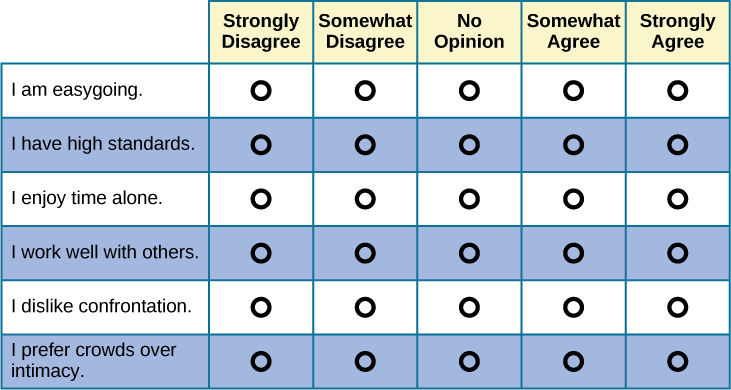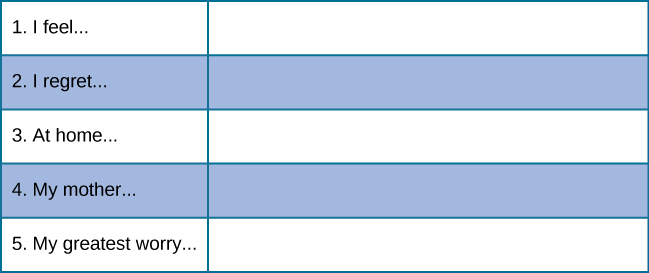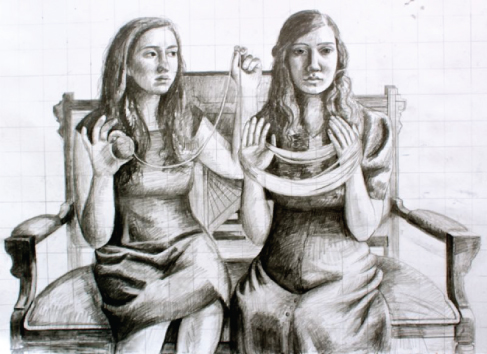Chapter 14. Personality
Personality Assessment
Amelia Liangzi Shi
Approximate reading time: 15 minutes
Learning Objectives
By the end of this section, you will be able to:
- Describe the Minnesota Multiphasic Personality Inventory
- Recognise and describe common projective tests used in personality assessment
Personality testing is often used to screen applicants for employment and job training. Personality tests are also used in criminal cases, custody battles, and assessments of psychological disorders. This section explores the best known among the many different types of personality tests and discusses the strengths and criticisms of each type.
Self-Report Inventories
Personality inventories are objective, standardized, and norm-based tests used to assess personality. They typically use multiple-choice items or numbered scales, which represent a range from 1, signalling strong disagreement, to 5, identifying strong agreement. They often are called Likert scales after their developer, Rensis Likert (1932).

Minnesota Multiphasic Personality Inventory (MMPI)
One of the most widely used personality inventories is the Minnesota Multiphasic Personality Inventory (MMPI), first published in 1943, with 504 true-false questions, and updated to the MMPI-2 in 1989, with 567 questions. In 2020, the test was again revised to the MMPI-3, with only 335 questions. Responses are scored to produce a clinical profile composed of 52 scales. The original MMPI was developed using an empirical or criterion keying approach, with clinical scales derived by selecting items that were endorsed by patients known to have been diagnosed with certain pathologies. The original MMPI was based on a small, limited sample, composed mostly of Minnesota farmers and psychiatric patients; the revised inventories were based on a more representative, national sample to allow for better standardization.
Watch this video: Advantages of the MMPI-3 (1.5 minutes)
“Advantages of the MMPI-3” video by Pearson Assessments US is licensed under the Standard YouTube licence.
![This chart provides an example of a questionnaire with five questions stacked vertically with and empty bubbles to the right of each question. Above the bubbles are the labels “True” and “False.” The questions include “I like gardening magazines,” “I am unhappy with my sex life,” “I feel like no one understands me,” “I think I would enjoy the work of a teacher,” and “I am not easily awakened by noise.” ]Although the MMPI was originally developed to assist in the clinical diagnosis of psychological disorders, it is now also used for occupational screening, such as in law enforcement, and in college, career, and marital counselling (Ben-Porath & Tellegen, 2008). An example of a questionnaire with True or False questions. The questions include “I like gardening magazines,” “I am unhappy with my sex life,” “I feel like no one understands me,” “I think I would enjoy the work of a teacher,” and “I am not easily awakened by noise.”](https://opentextbc.ca/psychologymtdi/wp-content/uploads/sites/470/2024/08/7fba806296bfb11e3727d1c09e6828179aca9ec5-1.jpg)
In addition to clinical scales, the tests also have validity and reliability scales. Recall the concepts of reliability and validity from your study of psychological research. One of the validity scales, the Lie Scale, or “L” Scale, consists of 15 items and is used to decide whether the respondent is “faking good” (i.e., presenting themselves in a favourable light). For example, if someone responds “yes” to a number of unrealistically positive items such as “I have never told a lie,” they may be trying to “fake good” or appear better than they actually are.
Reliability tests an instrument’s consistency over time, assuring that if you take the MMPI-3 today and then again five years later, your two scores will be similar. Beutler and colleagues (1988) gave the MMPI to newly recruited police officers and then to the same police officers two years later. After two years on the job, police officers’ responses indicated an increased vulnerability to alcoholism, somatic symptoms (i.e., vague, unexplained physical complaints), and anxiety. When the test was given an additional two years later — four years after starting on the job — the results suggested high risk for alcohol-related difficulties.
NEO Personality Inventory
Unlike MMPI, which was developed with an empirical approach, Paul Costa and Robert McCrae created NEO-PI questions based on the Big Five model. The NEO inventory originally covered only three traits: Neuroticism, Extraversion, and Openness. Later on, they added two more: Agreeableness and Conscientiousness (Costa & McCrae, 1985). Each trait or “domain” contains six “facets”. The inventory has been updated over time. In 2005, McCrae and colleagues made NEO-PI-3, which is better for adolescents and adults with lower reading levels. The NEO-PI-3 has 240 personality questions and some validity questions. Instead of presenting true or false items like in MMPI, NEO-PI uses a 5-point Likert scale (from strongly disagree to strongly agree). NEO-PIs are highly reliable and valid. They have been used in different places for counseling, hiring, and education (McCrae et al., 2005).
Domains and facets measured by the NEO-PI-3:
- Extraversion (E) facets
- E1: Warmth
- E2: Gregariousness
- E3: Assertiveness
- E4: Activity
- E5: Excitement-Seeking
- E6: Positive Emotions
- Agreeableness (A) facets
- A1: Trust
- A2: Straightforwardness
- A3: Altruism
- A4: Compliance
- A5: Modesty
- A6: Tender-Mindedness
- Neuroticism (N) facets
- N1: Anxiety
- N2: Angry Hostility
- N3: Depression
- N4: Self-Conciousness
- N5: Impulsiveness
- N6: Vulnerability
- Openness (O) facets
- O1: Fantasy
- O2: Aesthetics
- O3: Feelings
- O4: Actions
- O5: Ideas
- O6: Values
- Conscientiousness (C) facets
- C1: Competence
- C2: Order
- C3: Dutifulness
- C4: Achievement Striving
- C5: Self-Discipline
- C6: Deliberation
Projective Tests
Another method for the assessment of personality is projective testing. Projective tests rely on one of Freud’s defence mechanisms — projection — as a way to assess unconscious processes. In projective tests, a series of ambiguous cards is shown to the person being tested, who then is encouraged to project their feelings, impulses, and desires onto the cards, by telling a story, interpreting an image, or completing a sentence. The results are then interpreted by the test administrator. Many projective tests have undergone standardization procedures (e.g., Exner, 2002) and can be used to assess whether someone has unusual thoughts, a high level of anxiety, or is likely to become vulnerable to certain disorders.
Rorschach Inkblot Test
The Rorschach Inkblot Test was developed in 1921 by a Swiss psychologist named Hermann Rorschach. It is a series of symmetrical inkblot cards that are presented to a client by a psychologist. Upon presentation of each card, the psychologist asks the client, “What might this be?” What the test-taker sees reveals unconscious feelings and struggles (Piotrowski, 1987; Weiner, 2003). The Rorschach has been standardized and is effective in measuring depression, psychosis, and anxiety.

Thematic Apperception Test (TAT)
A second projective test is the Thematic Apperception Test (TAT), created in the 1930s by Henry Murray and Christiana Morgan. A person taking the TAT is shown eight to twelve ambiguous pictures and is asked to tell a story about each picture. The stories give insight into their social world, revealing hopes, fears, interests, and goals. The storytelling format helps to lower a person’s resistance to reveal unconscious personal details (Cramer, 2004). The TAT has been used in clinical settings to evaluate psychological disorders; more recently, it has been used in counselling settings to help clients gain a better understanding of themselves and achieve personal growth. Standardization of test administration is virtually nonexistent among clinicians, and the test tends to be modest to low on validity and reliability (Aronow et al., 2001; Lilienfeld et al., 2000). Despite these shortcomings, the TAT has been one of the most widely used projective tests.
Rotter Incomplete Sentences Blank (RISB)
A third projective test is the Rotter Incomplete Sentences Blank (RISB) developed by Julian Rotter in 1950. There are three forms of this test for use with different age groups: the school form, the college form, and the adult form. The tests include 40 incomplete sentences that people are asked to complete with one to two words in length. This test is similar to a word association test, and like other types of projective tests, it is presumed that responses will reveal desires, fears, and struggles. The RISB has been used in screening college students for adjustment problems and in career counselling (Holaday et al., 2010; Rotter & Rafferty 1950).

Projective Tests and Cultural Diversity
For many decades, these traditional projective tests have been used in cross-cultural personality assessments. Michelle Hoy-Watkins and Valata Jenkins-Monroe (2008) pointed out that the test bias restricted how well we can measure the behaviours and lifestyles of people from different cultural backgrounds. This happens when the questions in the test are based on information from just one culture or race, making it hard to accurately understand and assess individuals from diverse ethnocultural groups. For example, when the TAT was used with African American test-takers, the result was often shorter story length and low levels of cultural identification (Duzant, 2005). So, it was important to create different personality tests that looked into things like race, language, and how well someone has adapted to a new culture.
Contemporized-Themes Concerning Blacks Test (C-TCB)
To address this need, Robert Williams developed the first culturally specific projective test designed to reflect the everyday life experiences of African Americans. The updated version of the instrument is the Contemporized-Themes Concerning Blacks Test (C-TCB), which contains 20 colour images that show scenes of African American lifestyles (Williams, 1972). When the C-TCB was compared with the TAT for African Americans, it was found that use of the C-TCB led to increased story length, higher degrees of positive feelings, and stronger identification with the C-TCB (Hoy, 1997; Hoy-Watkins & Jenkins-Moore, 2008).

TEMAS Multicultural Thematic Apperception Test
The TEMAS Multicultural Thematic Apperception Test is another tool designed to be culturally relevant to minority groups, especially Hispanic youths. TEMAS stands for “Tell Me a Story,” but it’s also a play on the Spanish word temas (themes). TEMAS tries to make pictures and prompts that connect with both minority and nonminority children. It aims to show scenes that are familiar to everyone from everyday life in cities (Costantino & Malgady, 1999).
Evidence on Projective Tests
Despite their widespread use, the empirical evidence supporting the use of projective tests is mixed (Karon, 2000; Wood et al., 2003). The reliability of the measures is low because people often produce very different responses on different occasions. The validity of the measures is also questionable. There are very few consistent associations between Rorschach scores or TAT scores and most personality traits. The projective tests often fail to distinguish between people with psychological disorders and those without, and they often fail to correlate with other measures of personality or with behaviour. As such, projective tests are more useful as icebreakers to get to know a person better, to make the person feel comfortable, and to get some ideas about topics that may be of importance to that person rather than for accurately diagnosing personality.
Image Attributions
Figure PE.13. Figure 11.16 as found in Psychology 2e by OpenStax is licensed under a CC BY 4.0 License.
Figure PE.14. Figure 11.17 as found in Psychology 2e by OpenStax is licensed under a CC BY 4.0 License.
Figure PE.15. Rorschach Blot 02 by Hermann Rorschach is in the public domain; Rorschach Blot 08 by Hermann Rorschach is in the public domain; Rorschach Blot 09 by Hermann Rorschach is in the public domain; Rorschach Blot 10 by Hermann Rorschach is in the public domain.
Figure PE.16. Figure 11.19 as found in Psychology 2e by OpenStax is licensed under a CC BY 4.0 License.
Figure PE.17. ‘girls with yarn drawing’ by Rick&Brenda Beerhorst is published under a CC BY 2.0 Deed Attribution 2.0 Generic license.
To calculate this time, we used a reading speed of 150 words per minute and then added extra time to account for images and videos. This is just to give you a rough idea of the length of the chapter section. How long it will take you to engage with this chapter will vary greatly depending on all sorts of things (the complexity of the content, your ability to focus, etc).

